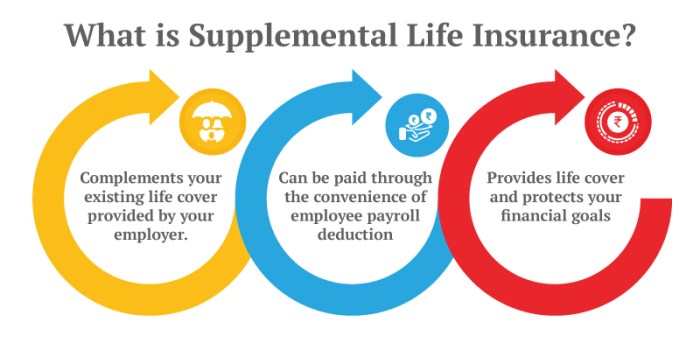Beyond the standard homeowner’s policy lies a crucial layer of protection: supplemental home insurance. While basic coverage addresses common perils, unforeseen events like floods, earthquakes, or significant liability claims can quickly deplete savings. Understanding the nuances of supplemental insurance is vital for safeguarding your most valuable asset—your home.
This guide dissects the complexities of supplemental home insurance, exploring various coverage options, cost factors, claims processes, and the critical decision of choosing the right provider. We’ll delve into specific scenarios to illustrate the tangible benefits and highlight the often-overlooked aspects that can significantly impact your financial well-being.
Defining Supplemental Home Insurance
Supplemental home insurance, often overlooked, provides crucial additional coverage beyond a standard homeowner’s policy, bolstering protection against unforeseen events and financial burdens. These policies are designed to address specific gaps in standard coverage, offering peace of mind for homeowners concerned about potential liabilities or unique property risks.Supplemental home insurance policies aim to fill the gaps left by standard homeowner’s insurance, offering protection against a broader range of risks and higher coverage limits for specific perils.
This allows homeowners to customize their insurance to better reflect their individual needs and the unique characteristics of their property. Unlike standard policies which focus on basic structural damage and liability, supplemental policies provide targeted coverage for specialized needs.
Types of Supplemental Home Insurance Coverage
Supplemental policies offer a variety of specialized coverages. Common examples include flood insurance, earthquake insurance, and high-value item coverage for jewelry, art, or collectibles. Umbrella liability insurance, which extends liability coverage beyond the limits of a standard policy, is another popular supplemental option.
These add-ons provide protection against events not typically included in basic homeowner’s insurance. For instance, a homeowner living in a flood-prone area might purchase supplemental flood insurance to protect their property from flood damage, a risk not typically covered by standard policies.
Comparison with Standard Homeowner’s Insurance
Standard homeowner’s insurance typically covers damage to the dwelling, personal belongings, and liability for accidents on the property. However, it often excludes specific events like floods, earthquakes, and acts of terrorism. Supplemental policies are designed to address these exclusions, providing additional coverage for these higher-risk events.
Standard policies usually have coverage limits, which may not be sufficient for high-value possessions or significant liability claims. Supplemental policies offer the flexibility to increase these limits, offering greater financial protection. The key difference lies in the specificity and breadth of coverage; standard policies offer foundational protection, while supplemental policies provide targeted, enhanced protection against specific risks.
Situations Benefiting from Supplemental Coverage
Supplemental coverage proves invaluable in various situations. For example, homeowners in areas prone to natural disasters, such as earthquakes or floods, should strongly consider supplemental insurance. Those with valuable collections or high-end electronics may need supplemental coverage for high-value items, as standard policies often have lower limits for such possessions.
Individuals with significant assets or high net worth might benefit from umbrella liability insurance to protect against potentially catastrophic liability claims. Homeowners who rent out a portion of their property, such as a basement apartment, should explore supplemental coverage for liability associated with tenants.
In each of these instances, the supplemental policy bridges the coverage gap, providing necessary financial protection against specific, high-risk events or situations.
Types of Supplemental Coverage

Supplemental home insurance policies offer crucial protection beyond standard coverage, mitigating risks that traditional policies often exclude. Understanding the various types available is key to securing comprehensive home protection tailored to individual needs and location-specific hazards. This section details common supplemental coverages, the risks they address, and illustrative examples of covered events.
Flood Insurance
Flood insurance protects against losses resulting from flooding, a peril typically excluded from standard homeowners’ policies. This coverage compensates for damage to the structure and its contents caused by overflowing rivers, lakes, or oceans, as well as heavy rainfall leading to water accumulation.
For example, a homeowner in a coastal area experiencing damage from a hurricane surge would be covered under a flood insurance policy, including damage to the foundation, walls, and personal belongings. The National Flood Insurance Program (NFIP) is a common source of flood insurance, offering various coverage options and deductibles.
Earthquake Insurance
Earthquake insurance provides financial protection against damage caused by seismic activity. This coverage is particularly crucial in areas prone to earthquakes, as standard homeowners’ policies generally exclude earthquake-related losses. An example of a covered event would be structural damage to a home caused by an earthquake, including cracked foundations, broken walls, and damaged chimneys.
Premiums for earthquake insurance vary significantly depending on location, proximity to fault lines, and the construction of the home.
Personal Liability Insurance
Personal liability insurance, often a component of a homeowners’ policy but sometimes offered as supplemental coverage, protects against financial losses resulting from accidents or injuries that occur on the homeowner’s property. This coverage can extend to legal fees and medical expenses incurred due to accidents involving guests or other individuals.
For instance, if a guest slips and falls on a homeowner’s icy walkway, resulting in a lawsuit, the personal liability insurance would help cover the associated costs. Coverage limits vary widely, and higher limits generally command higher premiums.
Other Supplemental Coverages
Beyond flood, earthquake, and personal liability, several other supplemental coverages exist to address specific risks. These might include coverage for water backup from sewers or drains, damage from windstorms exceeding standard policy limits, or specialized coverage for valuable collections (art, jewelry).
The availability and specifics of these supplemental policies depend on the insurance provider and the homeowner’s individual needs.
| Coverage Type | Coverage Limits (Example) | Annual Premium (Example) | Risk Addressed |
|---|---|---|---|
| Flood | $250,000 | $1,000 | Flooding from various sources |
| Earthquake | $100,000 | $500 | Seismic activity and resulting damage |
| Personal Liability | $500,000 | $200 | Liability for accidents on property |
| Windstorm (Supplemental) | $50,000 | $150 | Wind damage exceeding standard policy limits |
Factors Affecting Supplemental Insurance Costs
Supplemental home insurance premiums are determined by a complex interplay of factors, reflecting the insurer’s assessment of risk. Understanding these factors empowers homeowners to make informed decisions about their coverage and potentially lower their costs. This analysis explores key elements influencing the price of supplemental home insurance.
Location’s Impact on Supplemental Home Insurance Premiums
Geographic location significantly impacts supplemental home insurance costs. Areas prone to natural disasters, such as hurricanes, earthquakes, wildfires, or floods, command higher premiums due to the increased likelihood of claims. For example, a home in a coastal region susceptible to hurricanes will typically incur substantially higher premiums than a similar home located inland.
Similarly, homes situated in wildfire-prone areas of California or in earthquake zones in California or Japan will face elevated premiums. Insurers use sophisticated risk models incorporating historical claims data, geographic information systems (GIS), and meteorological forecasts to refine their risk assessments for specific locations.
These models consider factors like proximity to firebreaks, distance from water sources, and the type of building materials used in construction.
Age and Condition of the Home Influence on Premiums
The age and condition of a home are crucial factors in determining supplemental insurance costs. Older homes, especially those lacking modern safety features and building codes, generally carry higher premiums. This is because they are statistically more likely to suffer damage from various perils.
For instance, older electrical systems increase the risk of fire, while outdated plumbing increases the risk of water damage. Conversely, homes with recent renovations, updated systems, and proactive maintenance often qualify for lower premiums. Regular inspections, documented repairs, and the implementation of safety measures, such as smoke detectors and security systems, can positively influence premium calculations.
Insurers may even offer discounts for homes that meet specific safety standards.
Factors Increasing or Decreasing Supplemental Coverage Costs
Several factors can influence the cost of supplemental home insurance, either increasing or decreasing premiums.
The following factors generally increasepremiums:
- High-value possessions: Owning valuable items like jewelry, artwork, or antiques increases the potential payout in case of loss or damage, thus raising premiums.
- Poor credit history: Insurers often use credit scores as an indicator of risk, with lower credit scores correlating to higher premiums.
- Prior claims history: A history of filing insurance claims, even for minor incidents, can suggest a higher risk profile and lead to increased premiums.
- Specific coverage choices: Opting for broader or higher coverage limits naturally leads to higher premiums.
- Home features increasing risk: Features like a swimming pool, trampoline, or detached garage can increase the risk of accidents and liability claims, resulting in higher premiums.
- Lack of security systems: Homes without security systems, such as alarm systems or security cameras, may be deemed higher risk and therefore subject to higher premiums.
Conversely, these factors can lead to lowerpremiums:
- Home security systems: Installing security systems, such as burglar alarms or security cameras, can demonstrate a commitment to risk mitigation and result in lower premiums.
- Loss mitigation efforts: Implementing measures to reduce the risk of loss, such as fire sprinklers or flood mitigation systems, may earn discounts.
- Bundling policies: Combining home insurance with other policies, such as auto insurance, from the same insurer can often result in bundled discounts.
- Higher deductibles: Choosing a higher deductible reduces the insurer’s potential payout, leading to lower premiums.
- Maintaining a good credit score: A strong credit history can lead to favorable rates.
The Claims Process for Supplemental Home Insurance

Filing a claim for supplemental home insurance involves a series of steps designed to ensure a fair and efficient resolution. The process is generally straightforward, but understanding the requirements and timelines can help expedite the process and minimize stress during an already difficult time.
Prompt reporting and thorough documentation are key to a smooth claim experience.
Steps Involved in Filing a Supplemental Home Insurance Claim
The claims process typically begins with immediate notification to your insurance provider. This initial contact should be followed by a detailed written claim, supported by comprehensive documentation. The insurer will then investigate the claim, potentially requiring further information or an on-site inspection.
Once the investigation is complete, the insurer will assess the claim and determine the payout amount, which is then disbursed to the policyholder. This process can vary slightly depending on the specific insurer and the nature of the claim.
Required Documentation for a Supplemental Home Insurance Claim
Supporting a claim requires providing sufficient evidence to substantiate the loss or damage. This usually includes the original insurance policy, photographs or videos of the damage, repair estimates from licensed contractors, receipts for any related expenses incurred, and police reports if applicable (e.g., in cases of theft or vandalism).
Detailed descriptions of the incident, including date, time, and circumstances, are also crucial. In some cases, insurers may require sworn statements or witness testimonies. For example, a claim for water damage might require photos of the affected area, a plumber’s report detailing the cause and cost of repairs, and receipts for temporary accommodations if the damage renders the home uninhabitable.
Typical Timeframe for Claim Processing and Payout
The time it takes to process a supplemental home insurance claim varies greatly depending on the complexity of the claim and the insurer’s efficiency. Simple claims with readily available documentation may be processed within a few weeks, while more complex claims involving extensive damage or disputes could take several months.
Factors such as the availability of adjusters, the need for appraisals, and the insurer’s internal processing times all play a role. For example, a straightforward claim for a small appliance damaged in a power surge might be processed quickly, while a claim for significant wind damage following a hurricane could involve a much longer timeframe due to high claim volume and extensive damage assessments.
Flowchart Illustrating the Claims Process
A simplified flowchart representing the typical claims process would look like this:[Imagine a flowchart here. The flowchart would begin with “Incident Occurs,” branching to “Contact Insurer Immediately.” This would lead to “Submit Claim with Documentation (Policy, Photos, Estimates, etc.).” The next step would be “Insurer Investigates Claim (Potential On-site Inspection).” This then leads to “Claim Assessment and Determination of Payout.” Finally, the process ends with “Payout Disbursed to Policyholder.”] The flowchart visually depicts the sequential nature of the process, highlighting the importance of prompt reporting and thorough documentation at each stage.
Comparing Supplemental Home Insurance Providers
Choosing the right supplemental home insurance provider requires careful consideration of coverage options, pricing structures, and customer service. A thorough comparison across multiple providers is crucial to securing the best value and protection for your specific needs. This involves analyzing policy details, evaluating customer reviews, and understanding the strengths and weaknesses of each insurer.
Coverage Options and Pricing Comparisons
Different supplemental home insurance providers offer varying levels of coverage and pricing. For instance, one provider might offer extensive coverage for specific perils like flooding or earthquakes at a higher premium, while another might focus on more comprehensive coverage at a slightly lower cost but with higher deductibles.
A direct comparison of policy documents is essential to understand the nuances of each provider’s offerings. Factors such as your home’s location, age, and value will also significantly influence the final premium. For example, a provider might offer lower premiums for homes in low-risk areas compared to those in areas prone to natural disasters.
Policyholders should request detailed quotes from several providers to identify the best fit for their budget and risk profile.
Key Features to Consider When Selecting a Provider
Several key features distinguish supplemental home insurance providers. Financial stability, measured by A.M. Best ratings or similar independent assessments, is paramount. A high rating indicates a lower risk of the insurer’s inability to pay claims. Claims handling processes, including speed of response and ease of communication, should be investigated through customer reviews and independent surveys.
Policy flexibility, allowing for adjustments to coverage as needs change, is another valuable feature. Finally, the availability of various payment options and the insurer’s reputation for customer service should also be considered. A provider with a strong reputation for prompt and fair claim settlements and responsive customer service is preferable.
Examples of Customer Reviews and Ratings
While specific numerical ratings vary across platforms like Yelp, Google Reviews, and the Better Business Bureau, consistent themes emerge in customer reviews. Positive reviews often highlight efficient claims processing, responsive customer service representatives, and fair settlements. Negative reviews may focus on difficulties in reaching customer service, lengthy claim processing times, or disputes over coverage.
For example, one provider might consistently receive praise for its user-friendly online portal and quick claim approvals, while another might be criticized for slow response times and complicated claims procedures. Examining a range of reviews from different sources provides a balanced perspective.
Comparison of Supplemental Insurance Providers
| Provider | Strengths | Weaknesses | Average Customer Rating (Example) |
|---|---|---|---|
| Provider A | Competitive pricing, wide coverage options, strong financial rating | Customer service response times can be slow | 4.2 out of 5 stars |
| Provider B | Excellent customer service, fast claims processing | Higher premiums compared to competitors, limited coverage options | 4.5 out of 5 stars |
| Provider C | Strong online portal, various payment options, flexible policy adjustments | Lower financial rating compared to competitors | 3.8 out of 5 stars |
| Provider D | Specialized coverage for unique risks (e.g., high-value collectibles) | Higher deductibles, limited geographic availability | 4.0 out of 5 stars |
Understanding Policy Exclusions and Limitations

Supplemental home insurance, while offering valuable protection, is not a blanket guarantee against all potential losses. Understanding the policy’s exclusions and limitations is crucial to avoid disappointment during a claim. This section clarifies common exclusions and helps you assess whether supplemental coverage aligns with your specific needs.
Common Exclusions and Limitations in Supplemental Home Insurance Policies
Many supplemental policies exclude coverage for specific perils, pre-existing conditions, or situations deemed inherently risky by insurers. These exclusions vary depending on the provider and the specific policy, highlighting the importance of careful review before purchase. For example, flood damage is frequently excluded unless explicitly added as an endorsement, requiring a separate flood insurance policy for comprehensive protection.
Similarly, damage caused by gradual wear and tear, rather than a sudden event, is typically not covered.
Situations Where Supplemental Coverage May Not Apply
Supplemental insurance is designed to fill gaps in primary coverage, not replace it entirely. Consequently, claims may be denied if the loss is already covered by existing policies. For instance, if your homeowner’s insurance covers the full replacement cost of damaged belongings, a supplemental policy may not provide additional compensation.
Likewise, intentional acts or negligence on the part of the policyholder typically void coverage. Coverage limitations might also apply based on the age of the insured property or the value of specific items.
Examples of Specifically Excluded Events
Several events are commonly excluded from supplemental home insurance policies. These include, but are not limited to, losses due to nuclear events, war, or acts of terrorism. Damage resulting from mold infestation, often excluded unless caused by a covered event like a burst pipe, is another common example.
Furthermore, damage caused by pest infestations (e.g., termites) may not be covered unless it’s a direct result of a covered peril. Pre-existing damage, known to the policyholder before the policy inception, is usually excluded from coverage.
Questions to Ask an Insurance Provider Regarding Policy Exclusions
To ensure clarity and avoid future disputes, prospective policyholders should proactively seek information about policy exclusions. A comprehensive understanding of what is and is not covered is paramount. The following statements represent key areas of inquiry regarding policy limitations: The policy clearly defines events and circumstances excluded from coverage.
The policy specifies the limitations on coverage amounts for specific types of losses. The policy explains the process for appealing a claim denial due to an exclusion. The provider can provide examples of real-life claims where exclusions were applied.
The provider explains the implications of any endorsements or riders needed to extend coverage to specific situations.
Bundling Supplemental Coverage with Existing Policies
Bundling supplemental home insurance with an existing homeowner’s policy is a common practice offering potential cost savings and streamlined coverage. However, it’s crucial to carefully weigh the benefits against potential drawbacks before making a decision. Understanding the implications of bundling is key to securing comprehensive and affordable protection for your home.Bundling supplemental coverage with your primary homeowner’s insurance policy can lead to significant cost reductions through discounts offered by insurers.
These discounts incentivize policyholders to consolidate their coverage, rewarding loyalty and simplifying administrative processes for the insurance company. Conversely, bundling might not always be the most economical option, particularly if the supplemental coverage needs are minimal or if the insurer doesn’t offer competitive rates for bundled policies.
A thorough comparison of bundled and separate policies is therefore essential.
Cost Savings Associated with Bundling
Insurers frequently offer discounts for bundling supplemental coverage, such as flood or earthquake insurance, with existing homeowner’s policies. These discounts can range from a few percentage points to a more substantial reduction in the overall premium, depending on the insurer and the specific policies involved.
For instance, a homeowner might receive a 10% discount on their flood insurance premium by bundling it with their homeowner’s policy, resulting in considerable savings over the policy term. This discount structure reflects the reduced administrative costs and increased customer retention associated with bundled policies.
Situations Where Bundling is Advantageous
Bundling is particularly advantageous for homeowners in high-risk areas prone to specific perils. For example, a homeowner residing in a flood-prone zone would likely benefit from bundling flood insurance with their existing homeowner’s policy to ensure comprehensive protection against potential losses.
Similarly, homeowners in earthquake-prone regions would find bundling earthquake insurance advantageous. This approach streamlines claims processes, ensuring seamless coverage in the event of a covered loss. The convenience of dealing with a single insurer for all home-related insurance needs also simplifies the process significantly.
Comparison of Bundled Versus Separate Policies
The cost comparison between bundled and separate policies depends heavily on the insurer, the specific coverage, and the individual’s risk profile. In some cases, bundling can result in significant savings, while in others, separate policies might prove more cost-effective.
A hypothetical example could involve a homeowner comparing a bundled policy with a 15% discount against separate policies. If the discount outweighs the individual premiums for each separate policy, bundling would be more economical. Conversely, if the discount is minimal or non-existent, separate policies might offer better value.
It is crucial to obtain quotes from multiple insurers for both bundled and separate policies to make an informed decision.
The Role of Deductibles in Supplemental Home Insurance

Deductibles are a crucial component of supplemental home insurance policies, significantly impacting both the policy’s cost and the amount the insurer pays out in the event of a covered claim. Understanding how deductibles function is essential for consumers to make informed decisions about their coverage.Deductibles represent the amount of money the policyholder must pay out-of-pocket before the insurance company begins to cover the costs of a claim.
This means that even with supplemental insurance, a policyholder will still bear some financial responsibility in the event of a loss. The higher the deductible, the lower the premium, and vice-versa. This inverse relationship is a fundamental principle of insurance pricing.
Deductible Impact on Claim Costs
The deductible directly reduces the amount the insurance company pays for a covered claim. For instance, if a policyholder has a $1,000 deductible and suffers a $5,000 loss, the insurance company will only pay $4,000. The policyholder is responsible for the remaining $1,000.
This mechanism incentivizes policyholders to carefully consider the level of risk they are willing to assume versus the cost savings associated with a higher deductible.
Deductible Options and Implications
Supplemental home insurance providers typically offer a range of deductible options, allowing policyholders to tailor their coverage to their individual financial circumstances and risk tolerance. Common deductible options might include $500, $1,000, $2,500, or even higher amounts. A $500 deductible will result in a higher premium than a $2,500 deductible, but will require a smaller out-of-pocket payment in the event of a claim.
Choosing a higher deductible is generally a more cost-effective strategy for those who can comfortably absorb a larger initial expense, and who have a lower risk profile (e.g., those living in areas with low incidence of home-related disasters). Conversely, a lower deductible provides greater immediate financial protection, but comes at a higher premium cost.
Deductible Scenario: Claim Payout Illustration
Consider a homeowner with a supplemental insurance policy covering damage from severe weather. Their policy has a $1,000 deductible. A hailstorm causes $8,000 worth of damage to their roof. After the homeowner files a claim and the insurance company assesses the damage, the payout will be $7,000 ($8,000 total damage$1,000 deductible).
The homeowner is responsible for paying the initial $1,000 to cover the deductible before receiving the insurance payout. This scenario highlights the direct impact of the deductible on the final compensation received.
Legal Considerations for Supplemental Home Insurance
Supplemental home insurance, while offering crucial added protection, operates within a complex legal framework. Understanding the legal aspects of these policies is vital for both insurers and policyholders to ensure fair and transparent transactions and to avoid potential disputes. This section examines the key legal considerations, including the rights and responsibilities of each party, common dispute areas, and the resolution process.
Policy Contract Interpretation
Supplemental home insurance policies are legally binding contracts. The interpretation of these contracts relies heavily on the principle of “utmost good faith,” requiring both parties to act honestly and disclose all material information. Ambiguity in the policy wording is generally interpreted in favor of the insured.
Courts often look to the plain meaning of the language used, considering the context within the entire policy document. Disputes often arise from differing interpretations of policy terms, such as definitions of covered perils or the extent of liability. For instance, a disagreement might occur if the policy defines “flood” narrowly, excluding certain types of water damage that the insured believes should be covered.
Insurer’s Obligations
Insurers have a legal duty to act in good faith when handling claims. This includes promptly investigating claims, fairly assessing the damage, and paying valid claims within a reasonable timeframe. Failure to meet these obligations can lead to legal action by the insured.
For example, an insurer unreasonably delaying a claim payment for water damage, despite clear evidence of coverage, could face legal repercussions for breach of contract. State regulations often mandate specific timeframes for claim processing and payment, providing legal recourse for policyholders facing undue delays.
Insured’s Responsibilities
Policyholders also have legal responsibilities. These include accurately reporting the details of a claim, providing necessary documentation to support the claim, and cooperating with the insurer’s investigation. Failing to fulfill these obligations can jeopardize the claim. For example, an insured’s failure to provide timely notification of a loss, as stipulated in the policy, could result in the claim being denied.
Furthermore, providing false or misleading information during the claims process is a breach of contract and can lead to the insurer voiding the policy.
Common Disputes and Resolution
Common disputes involving supplemental home insurance often center on coverage issues, valuation of damages, and the interpretation of policy exclusions. Disputes may arise from disagreements over the cause of damage, the extent of the loss, or whether a particular peril is covered under the policy.
The process for resolving these disputes typically begins with attempts at informal negotiation between the insured and the insurer. If these attempts fail, the insured may pursue alternative dispute resolution methods, such as mediation or arbitration, before resorting to litigation.
Many states have regulatory bodies that oversee insurance practices and provide avenues for consumer complaints and dispute resolution. Legal action is usually a last resort, requiring significant time and expense.
Illustrative Scenarios of Supplemental Coverage in Action

Supplemental home insurance policies, while often overlooked, can prove invaluable in mitigating financial losses from unforeseen events not fully covered by standard homeowner’s insurance. Understanding how these policies function in real-world scenarios is crucial for informed decision-making. The following examples illustrate the practical application of supplemental coverage.
Flood Damage in a Coastal Community
Imagine a homeowner in a coastal town with a standard homeowner’s insurance policy. This policy typically excludes flood damage, a significant risk in their location. A severe hurricane causes widespread flooding, submerging the homeowner’s ground floor, damaging the foundation, and ruining appliances and furniture.
The total damage is estimated at $150,000. Their standard policy covers only the structural damage above the flood line, approximately $20,000. However, a supplemental flood insurance policy, purchased separately, covers the remaining $130,000 in damages, including the contents of the ground floor.
The claim process begins with filing a detailed report with the supplemental insurer, providing photographic evidence of the damage and receipts for damaged belongings. The insurer sends an adjuster to assess the damage, and after verification, the claim is processed and the homeowner receives the covered amount, minus any applicable deductible.
The entire process, from initial claim to payout, takes approximately six to eight weeks, depending on the insurer’s claims processing time and the complexity of the damage assessment.
Jewelry Theft from a Home Safe
A homeowner possesses a valuable jewelry collection, worth $50,000, stored in a home safe. Their standard homeowner’s policy offers limited coverage for jewelry theft, perhaps capping it at $2, Burglars break into the home and steal the safe containing the jewelry.
The homeowner’s standard policy only covers a small fraction of the loss. However, a supplemental policy specifically designed for valuable personal property covers the remaining $48,000, enabling the homeowner to replace their lost possessions. The claim process mirrors that of the flood damage scenario: filing a police report, providing photographic evidence, and working with the insurer’s adjuster to verify the value of the stolen items.
The claim is processed, and the homeowner receives the payout, less any deductible, typically within a similar timeframe.
Liability Claim Following a Guest’s Injury
A homeowner hosts a party, and a guest slips on a wet patch of floor, sustaining a significant leg injury requiring extensive medical treatment and rehabilitation. The guest sues the homeowner for medical expenses and pain and suffering. While the homeowner’s standard policy includes liability coverage, the potential payout might be insufficient to cover the extensive medical costs and potential legal fees.
A supplemental liability policy provides excess liability coverage, increasing the policy limit substantially. This ensures that the homeowner is adequately protected against the potentially high costs associated with the legal proceedings and the guest’s medical bills. The claim process involves notifying the insurer immediately, cooperating with the insurer’s legal team, and providing all relevant documentation.
The insurer manages the legal defense and negotiates a settlement or defends the homeowner in court. The supplemental policy’s payout would cover the legal fees and any settlement or judgment exceeding the standard policy’s liability limit.
Final Conclusion
Securing adequate supplemental home insurance isn’t just about mitigating risk; it’s about achieving true peace of mind. By carefully evaluating your individual needs, comparing providers, and understanding policy intricacies, you can create a comprehensive protection plan tailored to your specific circumstances.
Don’t leave your financial future vulnerable—proactively assess your coverage and ensure your home is adequately shielded against the unexpected.

